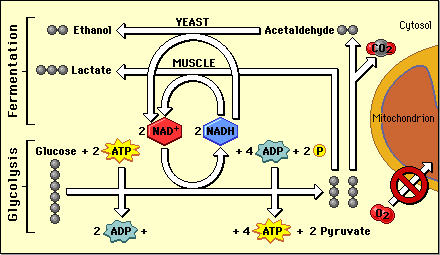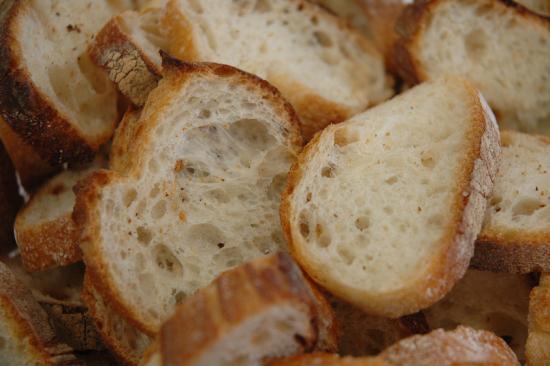5.10: Fermentation
- Page ID
- 16739
The muscles of this sprinter will need a lot of energy to complete their short race because they will be running at top speed. The action won't last long, but it will be very intense. The energy the sprinter needs can't be provided quickly enough by aerobic cellular respiration. Instead, a different process must be used by their muscle cells to power their activity.

Making ATP Without Oxygen
The cells of living things power their activities with the energy-carrying molecule ATP (adenosine triphosphate). The cells of most living things make ATP from glucose in the process of cellular respiration. This process occurs in three major stages, and one intermediate stage: glycolysis, oxidation of pyruvate, the Krebs cycle, and electron transport. The latter two stages require oxygen, making cellular respiration an aerobic process. There are also other ways of making ATP from glucose without oxygen, such as anaerobic respiration and fermentation, of making ATP from glucose without oxygen. Our cells do not perform anaerobic respiration. Therefore, we will only focus on fermentation in this section.

Fermentation
Fermentation starts with glycolysis, but it does not involve the latter two stages of aerobic cellular respiration (the Krebs cycle and oxidative phosphorylation). During glycolysis, two NAD+ electron carriers are reduced to two NADH molecules and 2 net ATPs are produced. The NADH must be oxidized back so that glycolysis can continue and cells can continue making 2 ATPs. The cells cannot make more than 2 ATP in fermentation because oxidative phosphorylation does not happen due to a lack of oxygen. There are two types of fermentation, alcoholic fermentation and lactic acid fermentation. Our cells can only perform lactic acid fermentation; however, we make use of both types of fermentation using other organisms.
Alcoholic Fermentation
Alcoholic fermentation The process by which this happens is summarized in Figure \(\PageIndex{2}\). The two pyruvate molecules are shown in this diagram come from the splitting of glucose through glycolysis. This process also produces 2 molecules of ATP. Continued breakdown of pyruvate produces acetaldehyde, carbon dioxide, and eventually ethanol. Alcoholic fermentation requires the electrons from NADH and results in the generation of NAD+.
Yeast in bread dough also uses alcoholic fermentation for energy and produces carbon dioxide gas as a waste product. The carbon dioxide that is released causes bubbles in the dough and explains why the dough rises. Do you see the small holes in the bread in Figure \(\PageIndex{3}\)? The holes were formed by bubbles of carbon dioxide gas.

Lactic Acid Fermentation
Lactic acid fermentation is carried out by certain bacteria, including the bacteria in yogurt. It is also carried out by your muscle cells when you work them hard and fast. This is how the muscles of the sprinter in Figure \(\PageIndex{1}\)get energy for their short-duration but intense activity. The process by which this happens is summarized in Figure \(\PageIndex{2}\). Again, two pyruvate and two ATP molecules result from glycolysis. Reduction of pyruvate using the electrons carried by NADH produces lactate (i.e. lactic acid). While this is similar to alcoholic fermentation, there is no carbon dioxide produced in this process.
Did you ever run a race, lift heavy weights, or participate in some other intense activity and notice that your muscles start to feel a burning sensation? This may occur when your muscle cells use lactic acid fermentation to provide ATP for energy. The buildup of lactic acid in the muscles causes the feeling of burning. The painful sensation is useful if it gets you to stop overworking your muscles and allow them a recovery period during which cells can eliminate the lactic acid.
Pros and Cons of Fermentation
With oxygen, organisms can use aerobic cellular respiration to produce up to 36 molecules of ATP from just one molecule of glucose. Without oxygen, some human cells must use fermentation to produce ATP, and this process produces only two molecules of ATP per molecule of glucose. Although fermentation produces less ATP, it has the advantage of doing so very quickly. It allows your muscles, for example, to get the energy they need for short bursts of intense activity. Aerobic cellular respiration, in contrast, produces ATP more slowly.
Myth: lactic acid build-up can cause muscle fatigue and a burning sensation in muscles. The soreness is thought to be due to microscopic damage to the muscle fibers.
Reality: The statement about lactic acid causing the burn in the muscle has no solid experimental proof. Alternate hypotheses suggest that through the production of lactic acid, the internal pH of the muscle decreases, triggering contraction in muscle due to the activation of motor neurons.
Review
- State the main difference between aerobic cellular respiration and fermentation.
- What is fermentation?
- Compare and contrast alcoholic and lactic acid fermentation.
- Identify the major pro and the major con of fermentation relative to aerobic cellular respiration.
- What process is shared between aerobic cellular respiration and fermentation? Describe the process briefly.
- Why is this process able to occur in fermentation as well as aerobic respiration?
- Which type of metabolic process occurs in the human body?
- Aerobic cellular respiration
- Alcoholic fermentation
- Lactic acid fermentation
- Both A and C
- True or False. Lactic acid fermentation produces carbon dioxide.
- True or False. Types of bacteria can carry out alcoholic fermentation and lactic acid fermentation.
- True or False. No ATP is produced by fermentation.
- Both lactic acid fermentation and alcoholic fermentation use which acid molecules to make their final products?
- Which type of process is used in the making of bread and wine?
- Alcoholic fermentation
- Lactic acid fermentation
- Aerobic cellular respiration
- Prokaryotic respiration
- Is fermentation an aerobic or anaerobic process?
- What is the reactant, or starting material, shared by aerobic respiration and both types of fermentation?
Explore More
While many people think that Brewers are artisans for their production of beer, in actuality, the true craft and process of beer making are due to anaerobic glycolysis from yeast. Learn more here:
Attributions
- Jimmy Vicaut by Marie-Lan Nguyen, licensed CC BY 3.0 via Wikimedia Commons
- Alcohol fermentation by Vtvu, licensed CC BY-SA 3.0 via Wikimedia Commons
- Bread by National Cancer Institute, public domain via Wikimedia Commons
- Text adapted from Human Biology by CK-12 licensed CC BY-NC 3.0


